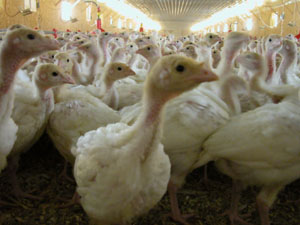By Shelley Grieshop
sgrieshop@dailystandard.com FORT RECOVERY -- Thousands of 4-week-old turkeys gather near Carl Link's plastic-covered shoes as he carefully walks inside the warm poultry barn in rural Fort Recovery.

"At this age they're not too afraid of you," says Link, a live production manager at nearby Cooper Farms.
As he shuffles through the sea of curious birds, the disposable neck-to-toe bio-suit he's wearing causes him to sweat. It's a small price to pay, he says, to protect a way of life for area poultry farmers.
Nearly every day the fight against the spread of Avian flu makes headlines across the world, scaring the public into a frenzy. State and local poultry farmers, however, are doing more than worrying; they've been busy beefing up regulations and reviewing procedures to prevent and/or prepare for the possibility of a bird flu outbreak.
"We've been monitoring flocks and preparing for something like this for several years," Link says. "I feel like (poultry) producers here have a good plan. Not that a (bird flu outbreak) couldn't happen here, it could happen anywhere. But we have to have some faith in scientists and biologists, too." The bird flu is an infection caused by Avian influenza viruses that occur naturally among birds. Wild birds worldwide carry the viruses in their intestines, but usually do not get sick from them -- they are mainly carriers. However, the bird virus is highly contagious among all birds and could easily infect and kill domesticated birds.
The Avian flu has become an epidemic in numerous Asian countries where more than 60 people have died after coming into contact with live, infected poultry. The virus, experts believe, is being spread through migratory birds whose flight patterns can take them across several continents in a single year.
Dr. Thomas Van't Hof, an expert in migratory bird behavior, says he wouldn't be surprised if the Avian flu hits the U.S. borders in less than two years.
"I believe it is more likely to be found here (Ohio) in the duck and geese population, which is more susceptible. The poultry industry is much more cared for, although the larger number of birds in close captivity could make the disease spread faster if it reaches them," says Van't Hof an assistant professor of biological sciences at Wright State University, Dayton.
He explains that birds have a higher body temperature than mammals and usually higher immune systems.
"That's why they generally carry disease but do not always succumb to it," he says.
Wild waterfowl have been known to carry low pathogenic viruses that cause mild illnesses in domesticated birds. But recent studies show that some migratory birds are now directly spreading the highly pathogenic form, which can be deadly to other birds, and subsequently to humans.
Dave Kohler of the Ohio Department of Natural Resources Division of Wildlife told The Daily Standard some of the waterfowl on Grand Lake are migratory, some are not. Supplemental feedings and man-made ponds, among other things, have suppressed the migratory urges in some birds.
"For example, some types of Canada geese we have in Ohio year-round, others migrate here from Canada," Kohler says.
Poultry is a multi-million dollar industry in Mercer and Darke counties. Within 30 miles of Fort Recovery there are 15 million laying chickens, Link says. Southern Mercer County and northern Darke County are considered the "poultry capitols of the world."
Mercer County alone boasts more than 10 million chickens and turkeys, and ranks at the top of the heap in turkey production across the state, according to statistics from the Ohio Department of Agriculture. Ohio is the second largest egg producing state in the nation.
So it's not surprising, with so much at stake, that local producers have gone the extra mile to prevent the Avian flu from devastating the industry.
"The Ohio Poultry Association not only has bio-security measures in place but we're meeting in November to make them even stronger," says Jim Chakeres, executive director of the organization.
Every turkey, broiler and layer flock is monitored closely; blood tests are routinely performed to detect the Avian flu or any other influenza, Chakeres says.
Members of the Ohio Poultry Association follow the National Poultry Improvement Plan that certifies all parent stocks and birds purchased are free of disease, he adds.
Chakeres said poultry in the U.S. does not come from other countries. Most local birds are either bred by area producers or are shipped here from breeders such as Hi-Line, based in Iowa, Chakeres explains.
Ralph Rindler, who operates a chicken farm in the St. Henry area, says he takes all recommended precautions with his birds like disinfecting their feed, prohibiting visitors on the premises and refusing to share equipment with other producers to avoid cross-contamination with other flocks.
Confident in the sanitary procedures he follows to protect the 1.3 million birds in his Mercer County operation, he is more fearful of the ducks and geese he shoos frequently from nearby ponds.
"Anytime you have something as dramatic as the Avian flu, you have to take precautions," he adds. |

